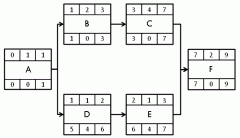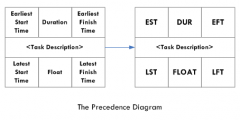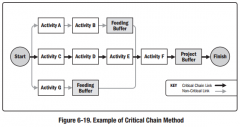![]()
![]()
![]()
Use LEFT and RIGHT arrow keys to navigate between flashcards;
Use UP and DOWN arrow keys to flip the card;
H to show hint;
A reads text to speech;
47 Cards in this Set
- Front
- Back
- 3rd side (hint)
|
Time Management (Knowledge Area)
|
Processes:
(1) Plan Schedule Management (2) Define Activities (3) Sequence Activities (4) Estimate Activity Resources (5) Estimate Activity Durations (6) Develop Schedule (7) Control Schedule |
7 total, 6 Ps, 1 M&C PSM, DA, SA, EAR, EAD, DS, CS |
|
|
CPM
|

Critical Path Method - used to estimate minimum project duration & amount of scheduling flexibility - sequence of activities that represent longest path, zero total float
|
|
|
|
CPM /Precedence Diagramming
|

|
|
|
|
Float
|
Formula: Late FInish - Early FInish
|
|
|
|
CCM
|

Critical Chain Method - Allows buffers on any project schedule path to account for limited resources and project uncertainties, resource-constrained critical path
Project Buffer - At end Feeding Buffer - placed on activities that feed critical chain |
|
|
|
Plan Schedule Management (Process)
|
Establishing policies, procedures, and documentation for how to manage the schedule
|
Output: Schedule Management Plan |
|
|
Schedule Management Plan (Output)
|
Components: (1) Schedule Model Development - methodology & tool(2) Level of accuracy - acceptable range for duration estimates (3) Units of measure - defined for each resource (4) Org procedures links - provides framework (5) Schedule model maintenance - process for updates to schedule (6) Control thresholds - percentage deviations for monitoring performance (7) Rules of performance measurement - Earned Value Management (8) Reporting formats - format and frequency (9) Process descriptions - for each schedule management process |
Output of "Plan Schedule Management" |
|
|
Define Activities (Process)
|
Identifying and documenting specific actions to be performed to produce project deliverablesTools: Decomposition & Rolling wave planning, expert judgment
|
Outputs: (1) Activity list (2) Activity attributes (3) Milestone list |
|
|
Rolling Wave Planning (Tool)
|
Iterative planning technique, near term work detailed, future work higher level
|
|
|
|
Activity List (Output)
|
Includes all schedule activities required on project, activity identifier, and scope
|
Output of "Define Activities" |
|
|
Activity Attributes (Output)
|
Extended description - person responsible, activity type, location of work, etc
|
Output of "Define Activities" |
|
|
Milestone List (Output)
|
List of milestones, zero durations, significant point or event in project
|
Output of "Define Activities" |
|
|
Sequence Activities (Process)
|
Relationships among project activities to obtain greatest efficiency given all constraints
Tools: PDM, Dependency determination, leads & lags |
Outputs: (1)Project schedule network diagram (2) Project documents updates |
|
|
PDM
|
Precedence Diagramming Method - constructing a schedule model represented by nodes (Ex. AON)
4 types of dependencies (FS, FF, SS, SF) |
|
|
|
FS
|
Finish to Start - successor cannot start until predecessor has finished
|
|
|
|
FF
|
Finish to Finish - Successor cannot finish until predecessor has finished (Ex. Writing document, editing document)
|
|
|
|
SS
|
Start to Start - Successor cannot start until predecessor has started (Ex. Leveling concrete, pouring foundation)
|
|
|
|
SF
|
Start to Finish - Successor cannot finish until predecessor has started (Ex. Security guard shifts, hand off)
|
|
|
|
AON
|

Activity-on-Node - type of Project Schedule Network Diagram
|
|
|
|
Dependency Determination (Tool)
|
Mandatory (Hard) or Discretionary
(Preferred/Preferential/Soft) Internal or External |
|
|
|
Lead
|
Amount of time a successor can be advanced with respect to predecessor
|
|
|
|
Lag
|
Amount of time successor will be delayed with respect to a predecessor
|
|
|
|
Project Schedule Network Diagrams (Output)
|

Graphical representation of logical relationships/dependencies
|
Output of "Sequence Activities" |
|
|
Estimate Activity Resources (Process)
|
Estimating type and quantities of material, human resources, equipment/supplies to perform each activity - more accurate cost and duration estimates
Tools: Alternative Analysis, Published estimating data, Bottom-up estimating |
Outputs: (1) Activity resource requirements (2) Resource breakdown structure |
|
|
Resource Calendars
|
Calendar that identifies working days and shifts on each specific resource availability
|
Output from "Acquire Project Team" and "Conduct Procurements" |
|
|
Activity Resource Requirements (Output)
|
Identify types and quantities of resources required for each activity in a work package
|
Output of "Estimate Activity Resources" |
|
|
Resource Breakdown Structure (Output)
|
Hierarchical representation of resources by category and type (labor, material, equipment, supplies)
|
Output of "Estimate Activity Resources" |
|
|
Estimate Activity Durations (Process)
|
Estimating number of work periods needed to complete individual activities with estimated resources - major input to Develop Schedule process
|
Output: Activity duration estimates |
|
|
Expert Judgment (Tool)
|
SME knowledge, historical information for estimates
|
|
|
|
Analogous Estimating (Tool)
|
Historical information, storytelling
3 lesses (Accurate, Time, Cost) |
|
|
|
Parametric Estimating (Tool)
|
Algorithm used to calculate cost or duration based on historical data and project parameters - unit of measure x amount or cost (ex. sq. footage in construction)
|
|
|
|
Three Point Estimating (Tool)
|
Program Evaluation and Review Technique (PERT) - 3 estimates to define approximate range for activity duration (P-M-O)
tP - Pessimistic, worst-case scenario tM - Most likely tO - Optimistic, best-case scenario |
|
|
|
Expected Duration (tE)
|
Triangular (Average) - (P+M+O)/3
Beta (Weighting) - (P+4M+O)/6 |
|
|
|
Variance Estimate
|
Formula: ((P-O)/6)squared
|
|
|
|
Standard Deviation Estimate
|
Formula:(P-O)/6
|
|
|
|
Group Decision Making Techniques (Tool)
|
Delphi - Anonymous voting
Nominal - Voting with ranking Dictatorship |
|
|
|
Reserve Analysis
|
Contingency Reserve (Time Reserves/Buffers) - Known Unknowns
Management Reserve - Unknown Unknowns, unforeseen work within scope, not in schedule baseline but part of project duration requirements |
|
|
|
Activity Duration Estimates
|
Do not include leads or lags, assessment of likely number of timer periods to complete activity (ex. 2 weeks +/- 2 days)
|
Output of "Estimate Activity Durations" |
|
|
Develop Schedule (Process)
|
Iterative process - generate schedule model with planned dates for completing project activities
Tools: Schedule network analysis, CPM, CCM, Resource optimization techniques, modeling techniques, schedule compression |
Outputs: (1) Schedule baseline (2) Project Schedule (3) Schedule Data (4) Project Calendars |
|
|
Resource Optimization (Tool)
|
Resource leveling - move dates to accommodate resources
Resource smoothing - Move resources to meet project dates |
|
|
|
Modeling Techniques (Tool)
|
What-If Scenario Analysis - predict effect (positive or negative) on project.assists with contingency and response planning
Simulation - calculating multiple project durations with different sets of activities (Monte Carlo analysis) |
|
|
|
Schedule Compression (Tool)
|
Crashing - Add resources, increases cost
Fast Tracking - Parallel activities, increases risk |
|
|
|
Schedule Baseline (Output)
|
Approved version of schedule model, only changed through change control processes, used for basis of comparison to actual results
|
Output of "Develop Schedule" |
|
|
Project Schedule (Output)
|
Schedule Presentations: Bar charts, milestone charts, Project schedule network diagrams (AON diagram)
|
Output of "Develop Schedule" |
|
|
Control Schedule (Process)
|
Monitoring the status of project activities to update project progress and manage changes to schedule baseline - provides means to recognize deviation from plan/minimize risk
|
Outputs: (1) Work Performance Information (2) Schedule forecasts (3) Change requests |
|
|
Performance Reviews (Tool)
|
Trend Analysis - Examines performance over time, improving or deteriorating
Critical Path Method (CPM) - Comparing progress along the critical path to determine schedule status Critical Chain Method (CCM) - Comparing amount of buffer remaining to amount of buffer needed Earned Value Management (EVM) - Schedule Variance (SV) and Schedule Performance Index (SPI) - assess magnitude of variation to original schedule baseline |
|
|
|
Schedule Forecasts (Output)
|
Estimates/predictions of conditions and events in project's future based on current knowledge at time of forecast, updated and reissued based on work performance info
|
Output of "Control Schedule" |

